An Analysis of CVP and Standard Costing in Hospitality and Healthcare
VerifiedAdded on 2019/12/03
|10
|2176
|421
Report
AI Summary
This report provides an in-depth analysis of Cost Volume Profit (CVP) analysis and standard costing, examining their application, advantages, and disadvantages within the hospitality and healthcare industries. The report begins with an introduction to both CVP analysis, which focuses on the impact of product costs and sales volume on profit, and standard costing, which substitutes expected expenditures with actual expenditures. The study then delves into the application of these techniques in the hospitality and tourism industry, illustrating how CVP analysis helps in determining break-even points and setting pricing strategies, while standard costing aids in variance analysis. The report also explores the application of these techniques in the healthcare industry, discussing how CVP analysis helps in determining fees and production capacity, and how standard costing assists in minimizing resource wastage through variance detection. The report includes examples, tables for variance analysis, and concludes by summarizing the suitability and limitations of these accounting techniques in the modern business era, highlighting their role in managerial decision-making and performance improvement.
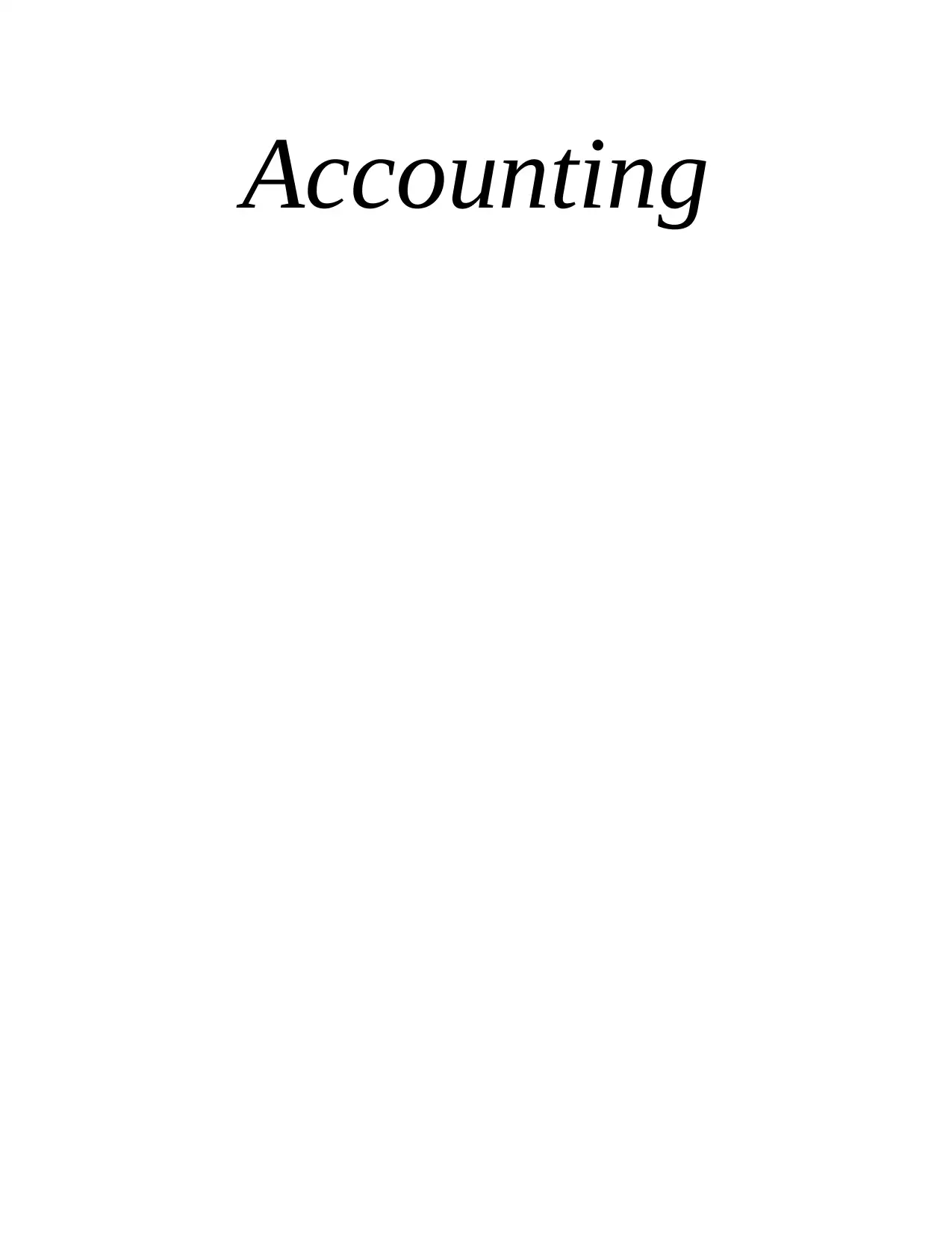
Accounting
Paraphrase This Document
Need a fresh take? Get an instant paraphrase of this document with our AI Paraphraser
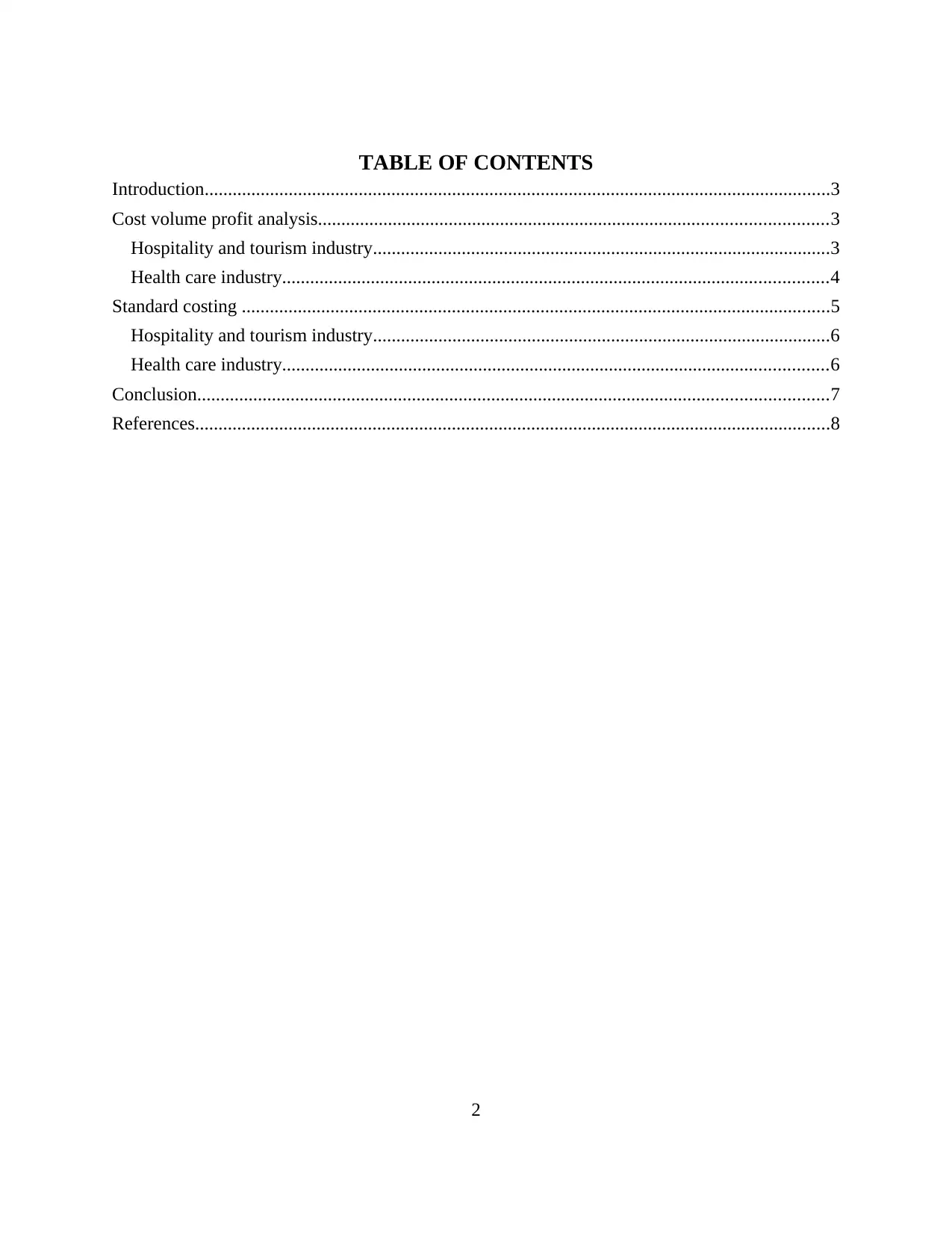
TABLE OF CONTENTS
Introduction......................................................................................................................................3
Cost volume profit analysis.............................................................................................................3
Hospitality and tourism industry..................................................................................................3
Health care industry.....................................................................................................................4
Standard costing ..............................................................................................................................5
Hospitality and tourism industry..................................................................................................6
Health care industry.....................................................................................................................6
Conclusion.......................................................................................................................................7
References........................................................................................................................................8
2
Introduction......................................................................................................................................3
Cost volume profit analysis.............................................................................................................3
Hospitality and tourism industry..................................................................................................3
Health care industry.....................................................................................................................4
Standard costing ..............................................................................................................................5
Hospitality and tourism industry..................................................................................................6
Health care industry.....................................................................................................................6
Conclusion.......................................................................................................................................7
References........................................................................................................................................8
2
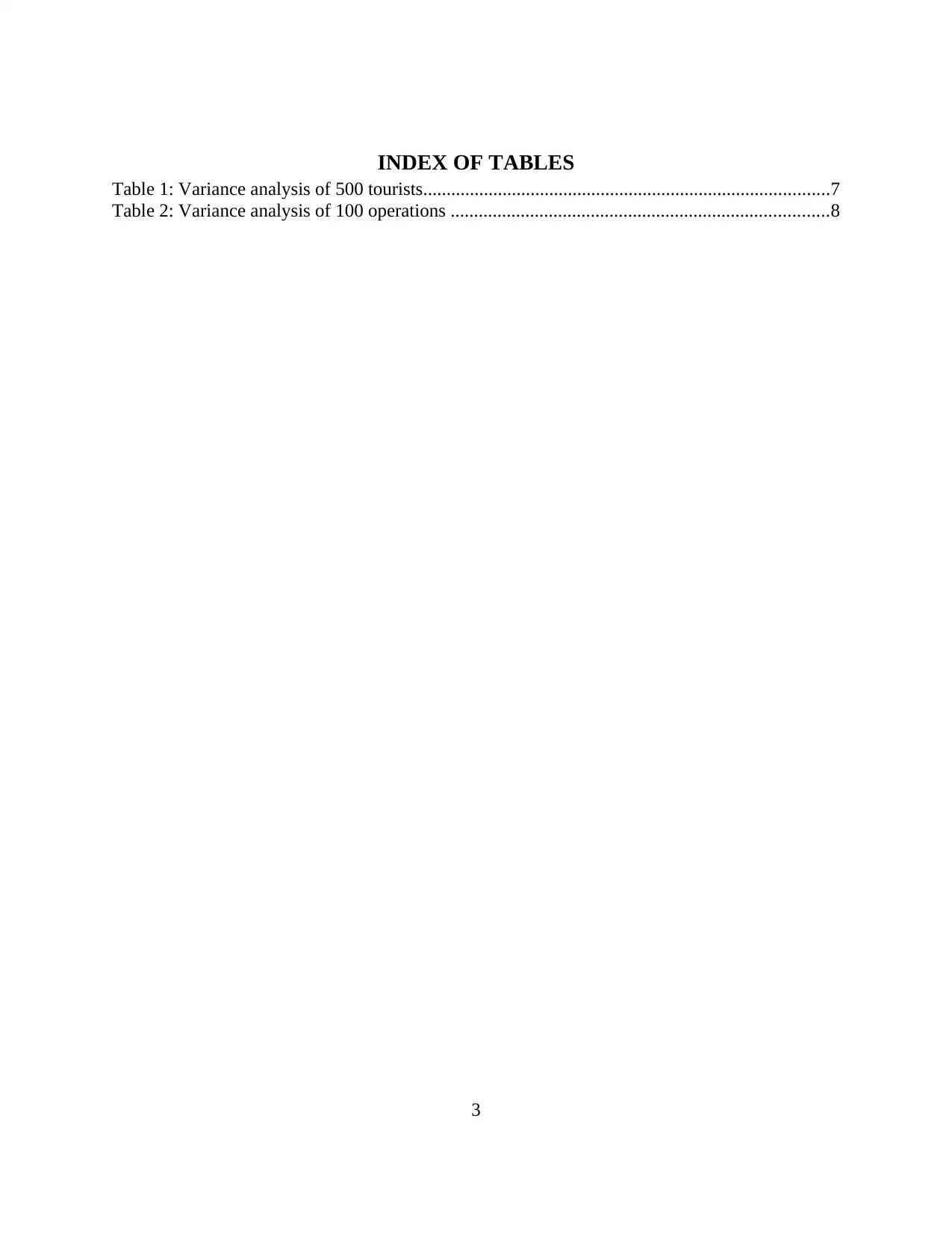
INDEX OF TABLES
Table 1: Variance analysis of 500 tourists.......................................................................................7
Table 2: Variance analysis of 100 operations .................................................................................8
3
Table 1: Variance analysis of 500 tourists.......................................................................................7
Table 2: Variance analysis of 100 operations .................................................................................8
3
⊘ This is a preview!⊘
Do you want full access?
Subscribe today to unlock all pages.

Trusted by 1+ million students worldwide
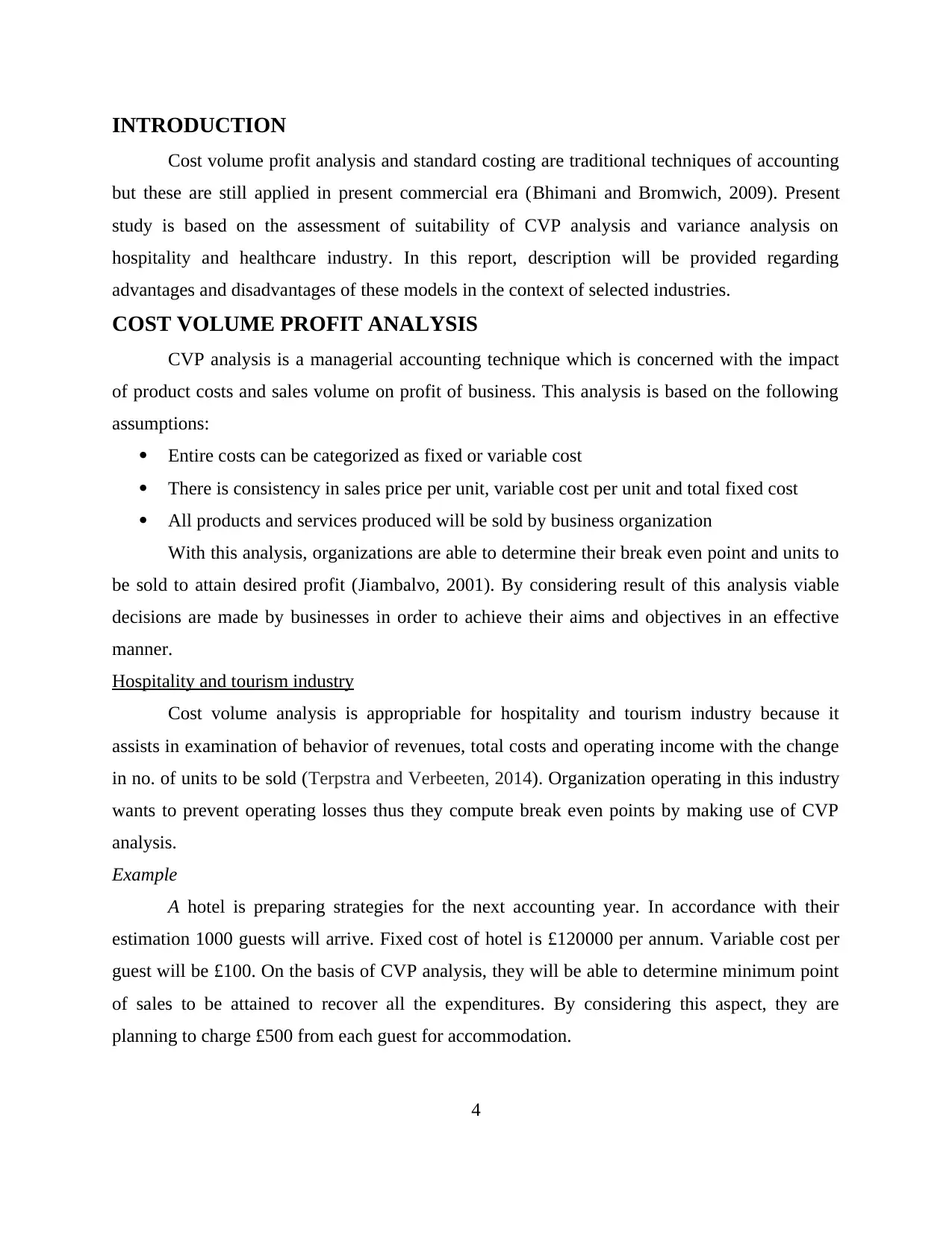
INTRODUCTION
Cost volume profit analysis and standard costing are traditional techniques of accounting
but these are still applied in present commercial era (Bhimani and Bromwich, 2009). Present
study is based on the assessment of suitability of CVP analysis and variance analysis on
hospitality and healthcare industry. In this report, description will be provided regarding
advantages and disadvantages of these models in the context of selected industries.
COST VOLUME PROFIT ANALYSIS
CVP analysis is a managerial accounting technique which is concerned with the impact
of product costs and sales volume on profit of business. This analysis is based on the following
assumptions:
Entire costs can be categorized as fixed or variable cost
There is consistency in sales price per unit, variable cost per unit and total fixed cost
All products and services produced will be sold by business organization
With this analysis, organizations are able to determine their break even point and units to
be sold to attain desired profit (Jiambalvo, 2001). By considering result of this analysis viable
decisions are made by businesses in order to achieve their aims and objectives in an effective
manner.
Hospitality and tourism industry
Cost volume analysis is appropriable for hospitality and tourism industry because it
assists in examination of behavior of revenues, total costs and operating income with the change
in no. of units to be sold (Terpstra and Verbeeten, 2014). Organization operating in this industry
wants to prevent operating losses thus they compute break even points by making use of CVP
analysis.
Example
A hotel is preparing strategies for the next accounting year. In accordance with their
estimation 1000 guests will arrive. Fixed cost of hotel is £120000 per annum. Variable cost per
guest will be £100. On the basis of CVP analysis, they will be able to determine minimum point
of sales to be attained to recover all the expenditures. By considering this aspect, they are
planning to charge £500 from each guest for accommodation.
4
Cost volume profit analysis and standard costing are traditional techniques of accounting
but these are still applied in present commercial era (Bhimani and Bromwich, 2009). Present
study is based on the assessment of suitability of CVP analysis and variance analysis on
hospitality and healthcare industry. In this report, description will be provided regarding
advantages and disadvantages of these models in the context of selected industries.
COST VOLUME PROFIT ANALYSIS
CVP analysis is a managerial accounting technique which is concerned with the impact
of product costs and sales volume on profit of business. This analysis is based on the following
assumptions:
Entire costs can be categorized as fixed or variable cost
There is consistency in sales price per unit, variable cost per unit and total fixed cost
All products and services produced will be sold by business organization
With this analysis, organizations are able to determine their break even point and units to
be sold to attain desired profit (Jiambalvo, 2001). By considering result of this analysis viable
decisions are made by businesses in order to achieve their aims and objectives in an effective
manner.
Hospitality and tourism industry
Cost volume analysis is appropriable for hospitality and tourism industry because it
assists in examination of behavior of revenues, total costs and operating income with the change
in no. of units to be sold (Terpstra and Verbeeten, 2014). Organization operating in this industry
wants to prevent operating losses thus they compute break even points by making use of CVP
analysis.
Example
A hotel is preparing strategies for the next accounting year. In accordance with their
estimation 1000 guests will arrive. Fixed cost of hotel is £120000 per annum. Variable cost per
guest will be £100. On the basis of CVP analysis, they will be able to determine minimum point
of sales to be attained to recover all the expenditures. By considering this aspect, they are
planning to charge £500 from each guest for accommodation.
4
Paraphrase This Document
Need a fresh take? Get an instant paraphrase of this document with our AI Paraphraser
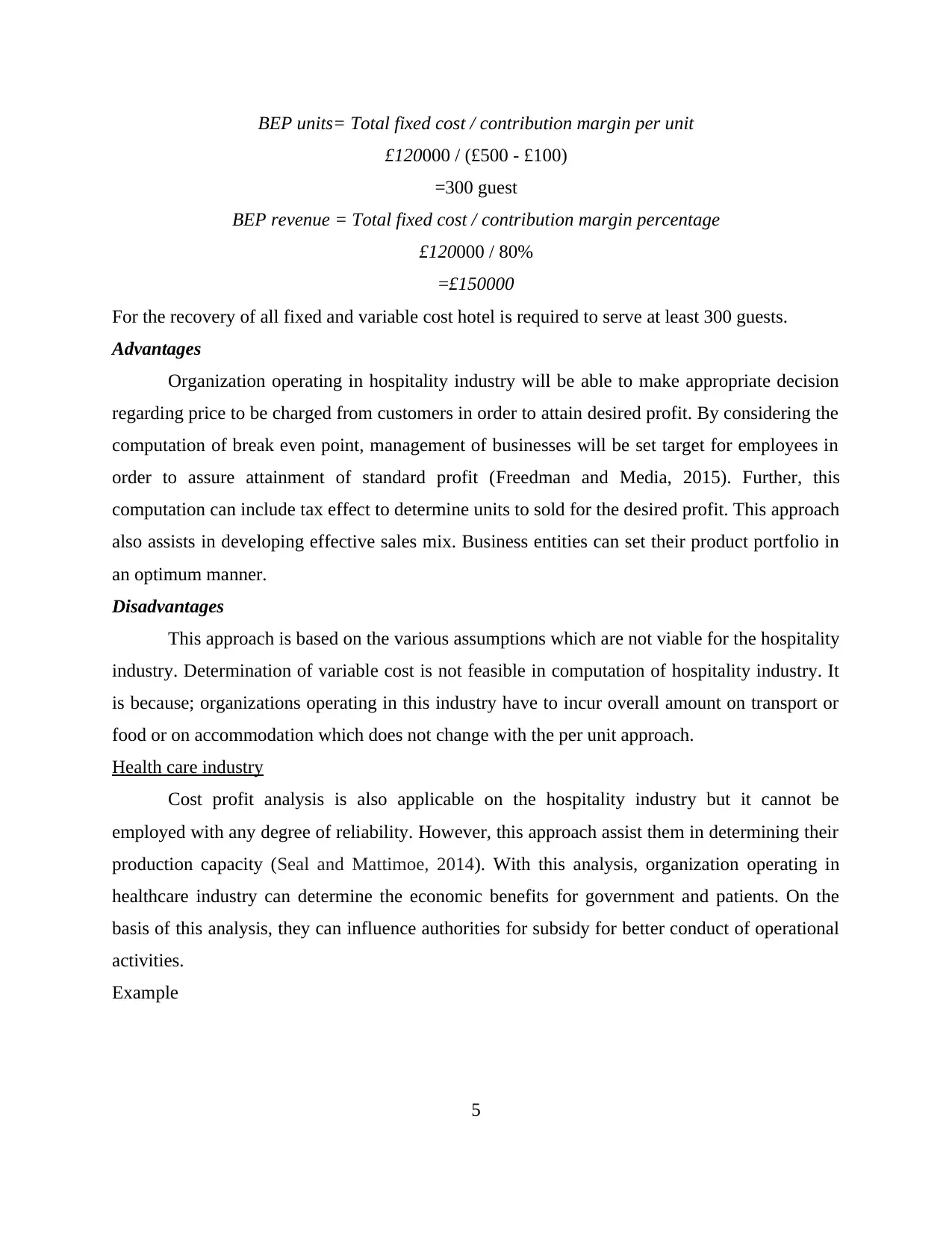
BEP units= Total fixed cost / contribution margin per unit
£120000 / (£500 - £100)
=300 guest
BEP revenue = Total fixed cost / contribution margin percentage
£120000 / 80%
=£150000
For the recovery of all fixed and variable cost hotel is required to serve at least 300 guests.
Advantages
Organization operating in hospitality industry will be able to make appropriate decision
regarding price to be charged from customers in order to attain desired profit. By considering the
computation of break even point, management of businesses will be set target for employees in
order to assure attainment of standard profit (Freedman and Media, 2015). Further, this
computation can include tax effect to determine units to sold for the desired profit. This approach
also assists in developing effective sales mix. Business entities can set their product portfolio in
an optimum manner.
Disadvantages
This approach is based on the various assumptions which are not viable for the hospitality
industry. Determination of variable cost is not feasible in computation of hospitality industry. It
is because; organizations operating in this industry have to incur overall amount on transport or
food or on accommodation which does not change with the per unit approach.
Health care industry
Cost profit analysis is also applicable on the hospitality industry but it cannot be
employed with any degree of reliability. However, this approach assist them in determining their
production capacity (Seal and Mattimoe, 2014). With this analysis, organization operating in
healthcare industry can determine the economic benefits for government and patients. On the
basis of this analysis, they can influence authorities for subsidy for better conduct of operational
activities.
Example
5
£120000 / (£500 - £100)
=300 guest
BEP revenue = Total fixed cost / contribution margin percentage
£120000 / 80%
=£150000
For the recovery of all fixed and variable cost hotel is required to serve at least 300 guests.
Advantages
Organization operating in hospitality industry will be able to make appropriate decision
regarding price to be charged from customers in order to attain desired profit. By considering the
computation of break even point, management of businesses will be set target for employees in
order to assure attainment of standard profit (Freedman and Media, 2015). Further, this
computation can include tax effect to determine units to sold for the desired profit. This approach
also assists in developing effective sales mix. Business entities can set their product portfolio in
an optimum manner.
Disadvantages
This approach is based on the various assumptions which are not viable for the hospitality
industry. Determination of variable cost is not feasible in computation of hospitality industry. It
is because; organizations operating in this industry have to incur overall amount on transport or
food or on accommodation which does not change with the per unit approach.
Health care industry
Cost profit analysis is also applicable on the hospitality industry but it cannot be
employed with any degree of reliability. However, this approach assist them in determining their
production capacity (Seal and Mattimoe, 2014). With this analysis, organization operating in
healthcare industry can determine the economic benefits for government and patients. On the
basis of this analysis, they can influence authorities for subsidy for better conduct of operational
activities.
Example
5
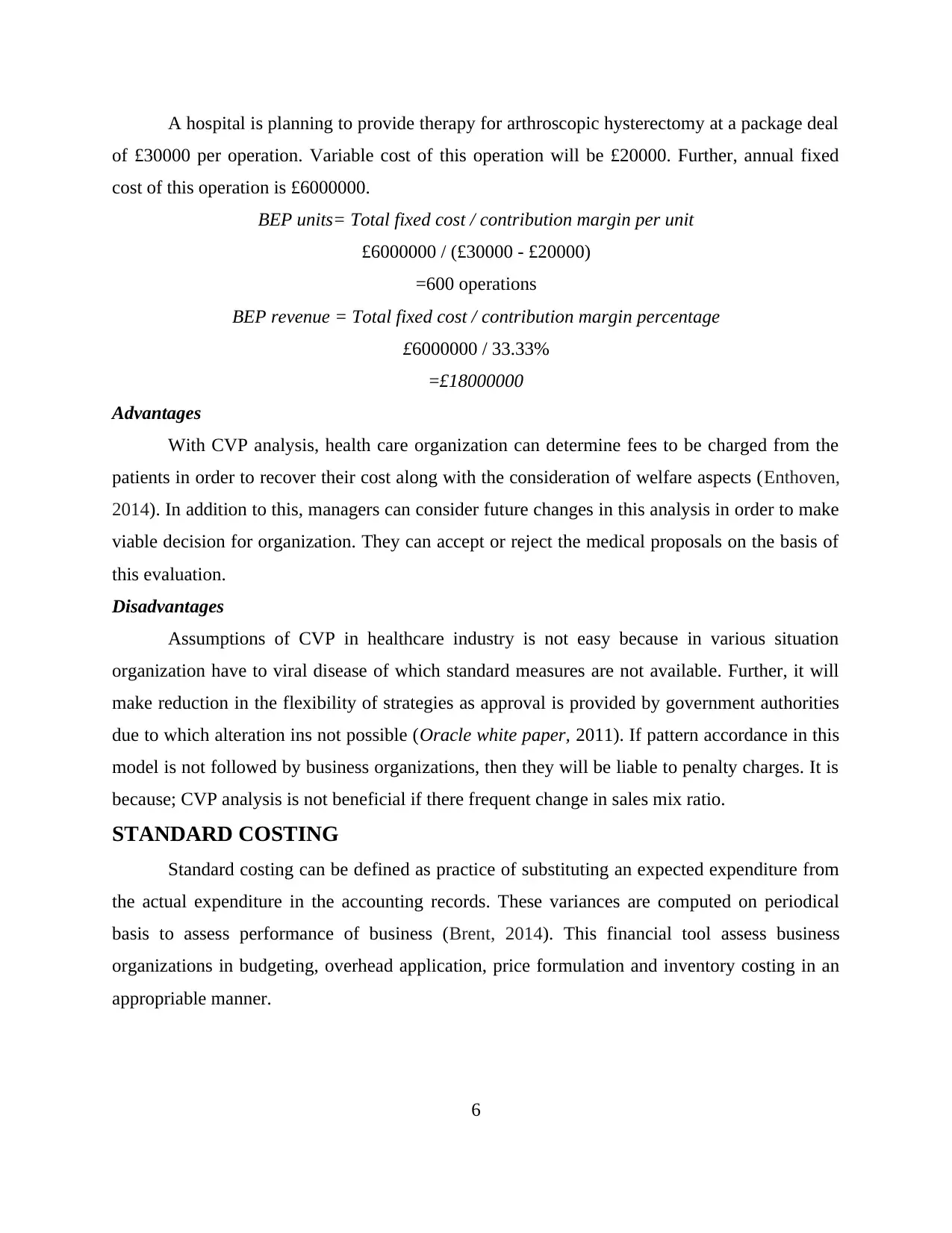
A hospital is planning to provide therapy for arthroscopic hysterectomy at a package deal
of £30000 per operation. Variable cost of this operation will be £20000. Further, annual fixed
cost of this operation is £6000000.
BEP units= Total fixed cost / contribution margin per unit
£6000000 / (£30000 - £20000)
=600 operations
BEP revenue = Total fixed cost / contribution margin percentage
£6000000 / 33.33%
=£18000000
Advantages
With CVP analysis, health care organization can determine fees to be charged from the
patients in order to recover their cost along with the consideration of welfare aspects (Enthoven,
2014). In addition to this, managers can consider future changes in this analysis in order to make
viable decision for organization. They can accept or reject the medical proposals on the basis of
this evaluation.
Disadvantages
Assumptions of CVP in healthcare industry is not easy because in various situation
organization have to viral disease of which standard measures are not available. Further, it will
make reduction in the flexibility of strategies as approval is provided by government authorities
due to which alteration ins not possible (Oracle white paper, 2011). If pattern accordance in this
model is not followed by business organizations, then they will be liable to penalty charges. It is
because; CVP analysis is not beneficial if there frequent change in sales mix ratio.
STANDARD COSTING
Standard costing can be defined as practice of substituting an expected expenditure from
the actual expenditure in the accounting records. These variances are computed on periodical
basis to assess performance of business (Brent, 2014). This financial tool assess business
organizations in budgeting, overhead application, price formulation and inventory costing in an
appropriable manner.
6
of £30000 per operation. Variable cost of this operation will be £20000. Further, annual fixed
cost of this operation is £6000000.
BEP units= Total fixed cost / contribution margin per unit
£6000000 / (£30000 - £20000)
=600 operations
BEP revenue = Total fixed cost / contribution margin percentage
£6000000 / 33.33%
=£18000000
Advantages
With CVP analysis, health care organization can determine fees to be charged from the
patients in order to recover their cost along with the consideration of welfare aspects (Enthoven,
2014). In addition to this, managers can consider future changes in this analysis in order to make
viable decision for organization. They can accept or reject the medical proposals on the basis of
this evaluation.
Disadvantages
Assumptions of CVP in healthcare industry is not easy because in various situation
organization have to viral disease of which standard measures are not available. Further, it will
make reduction in the flexibility of strategies as approval is provided by government authorities
due to which alteration ins not possible (Oracle white paper, 2011). If pattern accordance in this
model is not followed by business organizations, then they will be liable to penalty charges. It is
because; CVP analysis is not beneficial if there frequent change in sales mix ratio.
STANDARD COSTING
Standard costing can be defined as practice of substituting an expected expenditure from
the actual expenditure in the accounting records. These variances are computed on periodical
basis to assess performance of business (Brent, 2014). This financial tool assess business
organizations in budgeting, overhead application, price formulation and inventory costing in an
appropriable manner.
6
⊘ This is a preview!⊘
Do you want full access?
Subscribe today to unlock all pages.

Trusted by 1+ million students worldwide
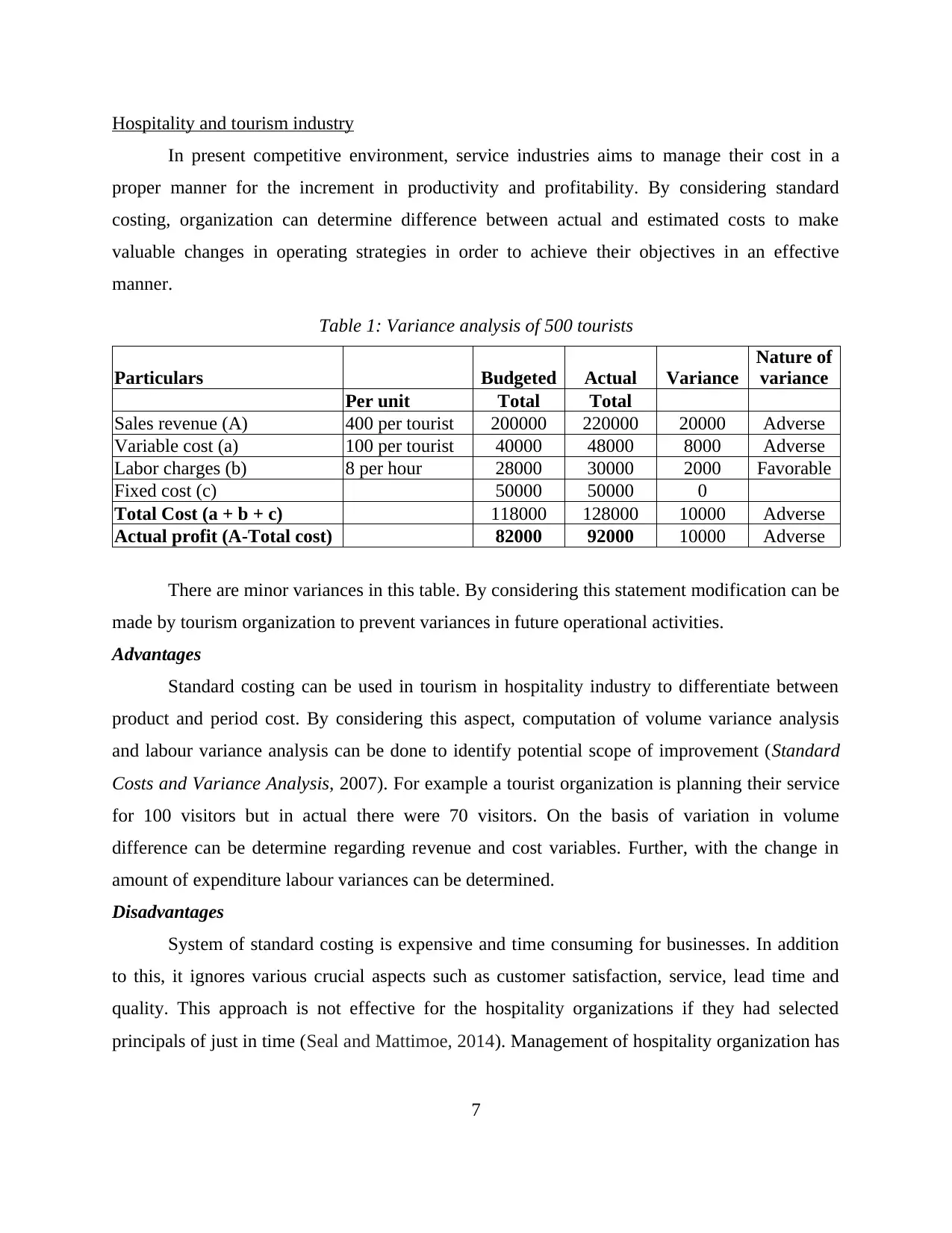
Hospitality and tourism industry
In present competitive environment, service industries aims to manage their cost in a
proper manner for the increment in productivity and profitability. By considering standard
costing, organization can determine difference between actual and estimated costs to make
valuable changes in operating strategies in order to achieve their objectives in an effective
manner.
Table 1: Variance analysis of 500 tourists
Particulars Budgeted Actual Variance
Nature of
variance
Per unit Total Total
Sales revenue (A) 400 per tourist 200000 220000 20000 Adverse
Variable cost (a) 100 per tourist 40000 48000 8000 Adverse
Labor charges (b) 8 per hour 28000 30000 2000 Favorable
Fixed cost (c) 50000 50000 0
Total Cost (a + b + c) 118000 128000 10000 Adverse
Actual profit (A-Total cost) 82000 92000 10000 Adverse
There are minor variances in this table. By considering this statement modification can be
made by tourism organization to prevent variances in future operational activities.
Advantages
Standard costing can be used in tourism in hospitality industry to differentiate between
product and period cost. By considering this aspect, computation of volume variance analysis
and labour variance analysis can be done to identify potential scope of improvement (Standard
Costs and Variance Analysis, 2007). For example a tourist organization is planning their service
for 100 visitors but in actual there were 70 visitors. On the basis of variation in volume
difference can be determine regarding revenue and cost variables. Further, with the change in
amount of expenditure labour variances can be determined.
Disadvantages
System of standard costing is expensive and time consuming for businesses. In addition
to this, it ignores various crucial aspects such as customer satisfaction, service, lead time and
quality. This approach is not effective for the hospitality organizations if they had selected
principals of just in time (Seal and Mattimoe, 2014). Management of hospitality organization has
7
In present competitive environment, service industries aims to manage their cost in a
proper manner for the increment in productivity and profitability. By considering standard
costing, organization can determine difference between actual and estimated costs to make
valuable changes in operating strategies in order to achieve their objectives in an effective
manner.
Table 1: Variance analysis of 500 tourists
Particulars Budgeted Actual Variance
Nature of
variance
Per unit Total Total
Sales revenue (A) 400 per tourist 200000 220000 20000 Adverse
Variable cost (a) 100 per tourist 40000 48000 8000 Adverse
Labor charges (b) 8 per hour 28000 30000 2000 Favorable
Fixed cost (c) 50000 50000 0
Total Cost (a + b + c) 118000 128000 10000 Adverse
Actual profit (A-Total cost) 82000 92000 10000 Adverse
There are minor variances in this table. By considering this statement modification can be
made by tourism organization to prevent variances in future operational activities.
Advantages
Standard costing can be used in tourism in hospitality industry to differentiate between
product and period cost. By considering this aspect, computation of volume variance analysis
and labour variance analysis can be done to identify potential scope of improvement (Standard
Costs and Variance Analysis, 2007). For example a tourist organization is planning their service
for 100 visitors but in actual there were 70 visitors. On the basis of variation in volume
difference can be determine regarding revenue and cost variables. Further, with the change in
amount of expenditure labour variances can be determined.
Disadvantages
System of standard costing is expensive and time consuming for businesses. In addition
to this, it ignores various crucial aspects such as customer satisfaction, service, lead time and
quality. This approach is not effective for the hospitality organizations if they had selected
principals of just in time (Seal and Mattimoe, 2014). Management of hospitality organization has
7
Paraphrase This Document
Need a fresh take? Get an instant paraphrase of this document with our AI Paraphraser
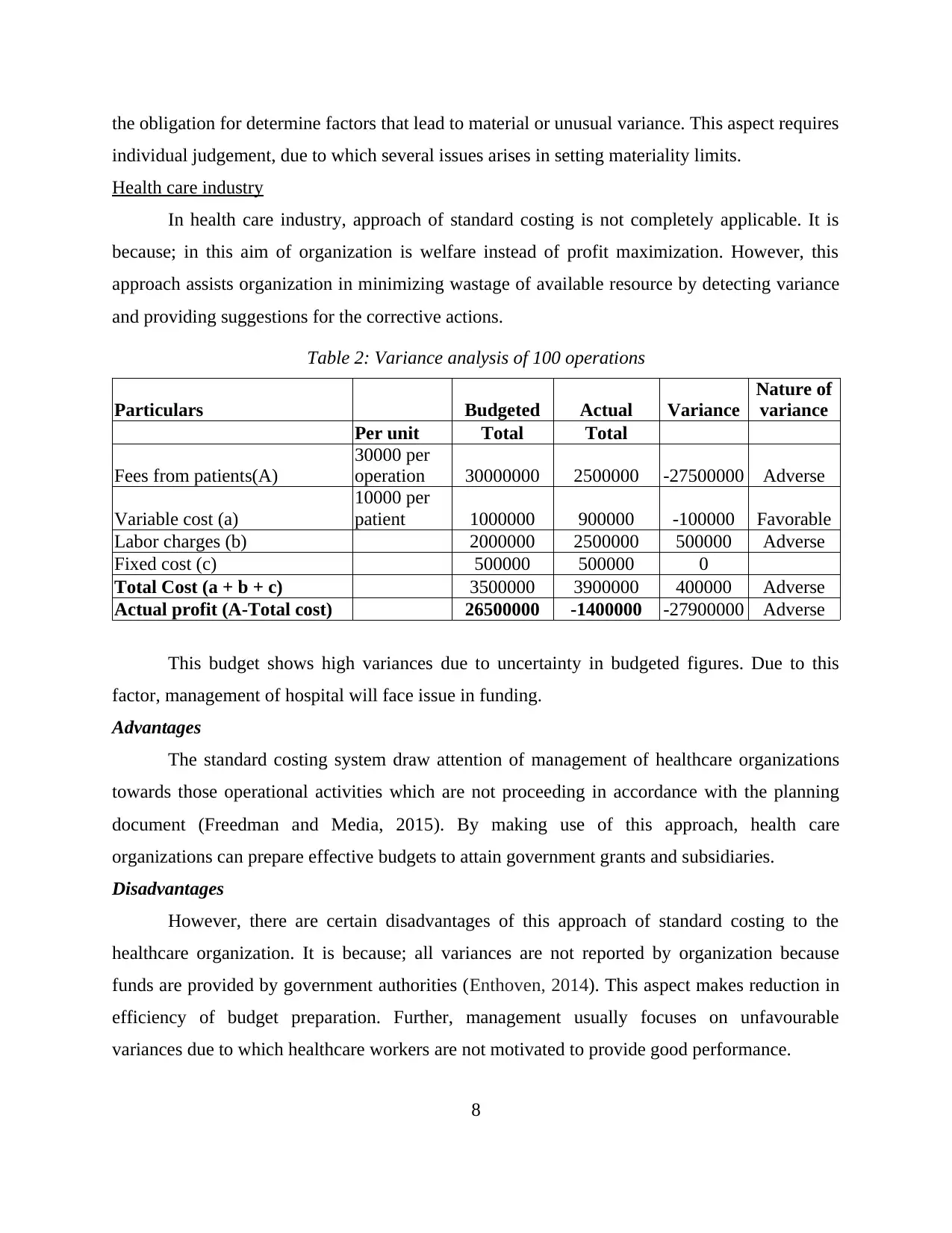
the obligation for determine factors that lead to material or unusual variance. This aspect requires
individual judgement, due to which several issues arises in setting materiality limits.
Health care industry
In health care industry, approach of standard costing is not completely applicable. It is
because; in this aim of organization is welfare instead of profit maximization. However, this
approach assists organization in minimizing wastage of available resource by detecting variance
and providing suggestions for the corrective actions.
Table 2: Variance analysis of 100 operations
Particulars Budgeted Actual Variance
Nature of
variance
Per unit Total Total
Fees from patients(A)
30000 per
operation 30000000 2500000 -27500000 Adverse
Variable cost (a)
10000 per
patient 1000000 900000 -100000 Favorable
Labor charges (b) 2000000 2500000 500000 Adverse
Fixed cost (c) 500000 500000 0
Total Cost (a + b + c) 3500000 3900000 400000 Adverse
Actual profit (A-Total cost) 26500000 -1400000 -27900000 Adverse
This budget shows high variances due to uncertainty in budgeted figures. Due to this
factor, management of hospital will face issue in funding.
Advantages
The standard costing system draw attention of management of healthcare organizations
towards those operational activities which are not proceeding in accordance with the planning
document (Freedman and Media, 2015). By making use of this approach, health care
organizations can prepare effective budgets to attain government grants and subsidiaries.
Disadvantages
However, there are certain disadvantages of this approach of standard costing to the
healthcare organization. It is because; all variances are not reported by organization because
funds are provided by government authorities (Enthoven, 2014). This aspect makes reduction in
efficiency of budget preparation. Further, management usually focuses on unfavourable
variances due to which healthcare workers are not motivated to provide good performance.
8
individual judgement, due to which several issues arises in setting materiality limits.
Health care industry
In health care industry, approach of standard costing is not completely applicable. It is
because; in this aim of organization is welfare instead of profit maximization. However, this
approach assists organization in minimizing wastage of available resource by detecting variance
and providing suggestions for the corrective actions.
Table 2: Variance analysis of 100 operations
Particulars Budgeted Actual Variance
Nature of
variance
Per unit Total Total
Fees from patients(A)
30000 per
operation 30000000 2500000 -27500000 Adverse
Variable cost (a)
10000 per
patient 1000000 900000 -100000 Favorable
Labor charges (b) 2000000 2500000 500000 Adverse
Fixed cost (c) 500000 500000 0
Total Cost (a + b + c) 3500000 3900000 400000 Adverse
Actual profit (A-Total cost) 26500000 -1400000 -27900000 Adverse
This budget shows high variances due to uncertainty in budgeted figures. Due to this
factor, management of hospital will face issue in funding.
Advantages
The standard costing system draw attention of management of healthcare organizations
towards those operational activities which are not proceeding in accordance with the planning
document (Freedman and Media, 2015). By making use of this approach, health care
organizations can prepare effective budgets to attain government grants and subsidiaries.
Disadvantages
However, there are certain disadvantages of this approach of standard costing to the
healthcare organization. It is because; all variances are not reported by organization because
funds are provided by government authorities (Enthoven, 2014). This aspect makes reduction in
efficiency of budget preparation. Further, management usually focuses on unfavourable
variances due to which healthcare workers are not motivated to provide good performance.
8
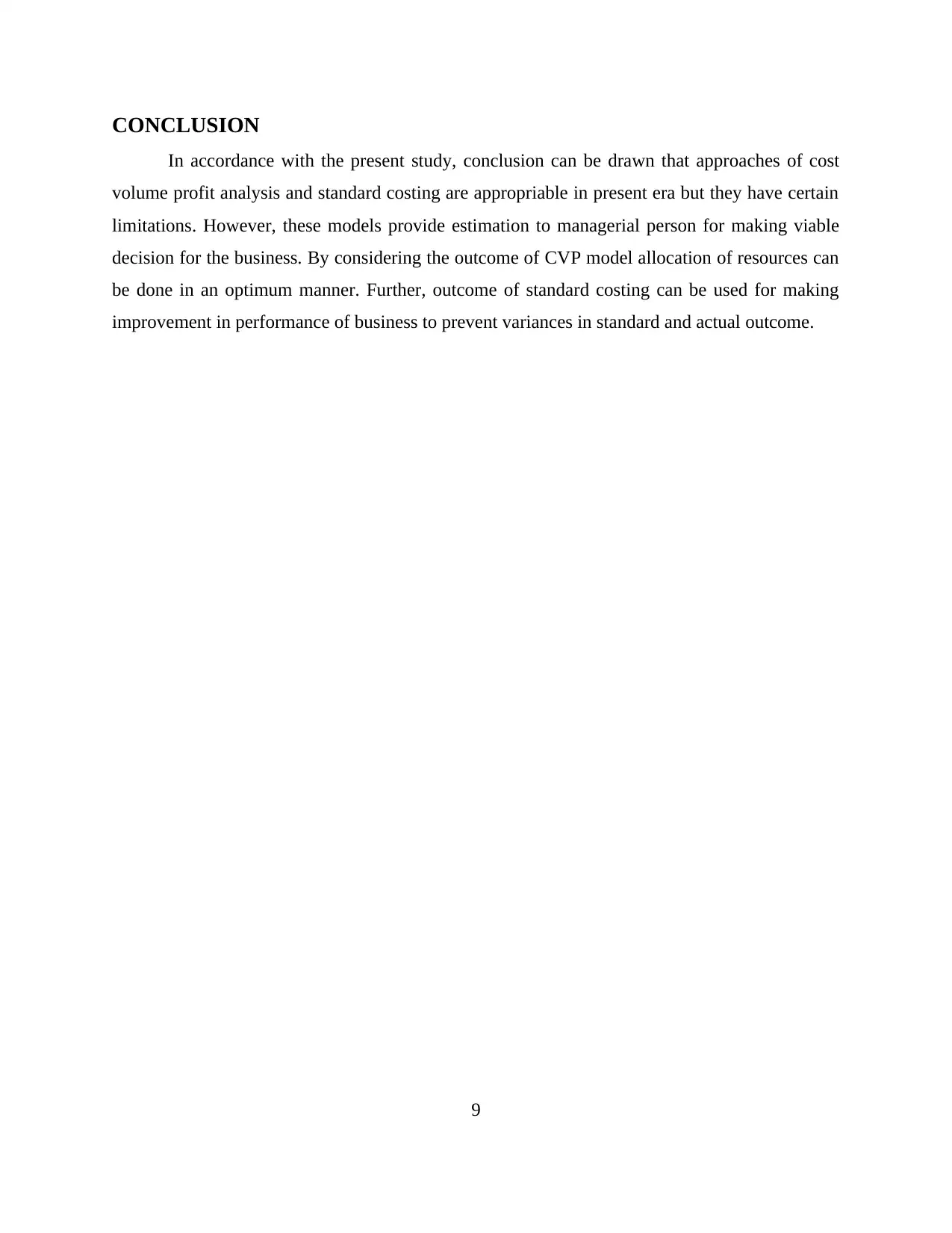
CONCLUSION
In accordance with the present study, conclusion can be drawn that approaches of cost
volume profit analysis and standard costing are appropriable in present era but they have certain
limitations. However, these models provide estimation to managerial person for making viable
decision for the business. By considering the outcome of CVP model allocation of resources can
be done in an optimum manner. Further, outcome of standard costing can be used for making
improvement in performance of business to prevent variances in standard and actual outcome.
9
In accordance with the present study, conclusion can be drawn that approaches of cost
volume profit analysis and standard costing are appropriable in present era but they have certain
limitations. However, these models provide estimation to managerial person for making viable
decision for the business. By considering the outcome of CVP model allocation of resources can
be done in an optimum manner. Further, outcome of standard costing can be used for making
improvement in performance of business to prevent variances in standard and actual outcome.
9
⊘ This is a preview!⊘
Do you want full access?
Subscribe today to unlock all pages.

Trusted by 1+ million students worldwide
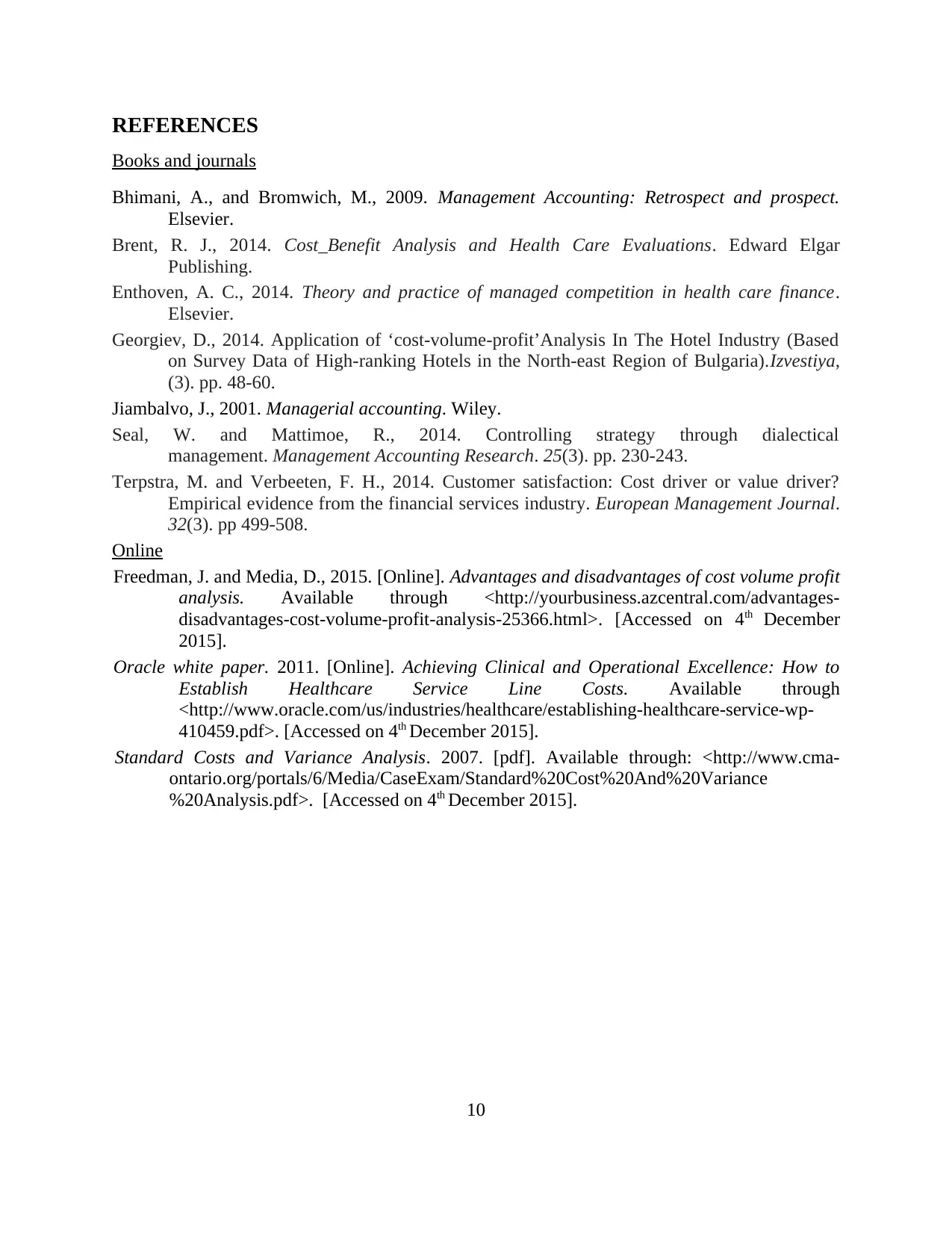
REFERENCES
Books and journals
Bhimani, A., and Bromwich, M., 2009. Management Accounting: Retrospect and prospect.
Elsevier.
Brent, R. J., 2014. Cost_Benefit Analysis and Health Care Evaluations. Edward Elgar
Publishing.
Enthoven, A. C., 2014. Theory and practice of managed competition in health care finance.
Elsevier.
Georgiev, D., 2014. Application of ‘cost-volume-profit’Analysis In The Hotel Industry (Based
on Survey Data of High-ranking Hotels in the North-east Region of Bulgaria).Izvestiya,
(3). pp. 48-60.
Jiambalvo, J., 2001. Managerial accounting. Wiley.
Seal, W. and Mattimoe, R., 2014. Controlling strategy through dialectical
management. Management Accounting Research. 25(3). pp. 230-243.
Terpstra, M. and Verbeeten, F. H., 2014. Customer satisfaction: Cost driver or value driver?
Empirical evidence from the financial services industry. European Management Journal.
32(3). pp 499-508.
Online
Freedman, J. and Media, D., 2015. [Online]. Advantages and disadvantages of cost volume profit
analysis. Available through <http://yourbusiness.azcentral.com/advantages-
disadvantages-cost-volume-profit-analysis-25366.html>. [Accessed on 4th December
2015].
Oracle white paper. 2011. [Online]. Achieving Clinical and Operational Excellence: How to
Establish Healthcare Service Line Costs. Available through
<http://www.oracle.com/us/industries/healthcare/establishing-healthcare-service-wp-
410459.pdf>. [Accessed on 4th December 2015].
Standard Costs and Variance Analysis. 2007. [pdf]. Available through: <http://www.cma-
ontario.org/portals/6/Media/CaseExam/Standard%20Cost%20And%20Variance
%20Analysis.pdf>. [Accessed on 4th December 2015].
10
Books and journals
Bhimani, A., and Bromwich, M., 2009. Management Accounting: Retrospect and prospect.
Elsevier.
Brent, R. J., 2014. Cost_Benefit Analysis and Health Care Evaluations. Edward Elgar
Publishing.
Enthoven, A. C., 2014. Theory and practice of managed competition in health care finance.
Elsevier.
Georgiev, D., 2014. Application of ‘cost-volume-profit’Analysis In The Hotel Industry (Based
on Survey Data of High-ranking Hotels in the North-east Region of Bulgaria).Izvestiya,
(3). pp. 48-60.
Jiambalvo, J., 2001. Managerial accounting. Wiley.
Seal, W. and Mattimoe, R., 2014. Controlling strategy through dialectical
management. Management Accounting Research. 25(3). pp. 230-243.
Terpstra, M. and Verbeeten, F. H., 2014. Customer satisfaction: Cost driver or value driver?
Empirical evidence from the financial services industry. European Management Journal.
32(3). pp 499-508.
Online
Freedman, J. and Media, D., 2015. [Online]. Advantages and disadvantages of cost volume profit
analysis. Available through <http://yourbusiness.azcentral.com/advantages-
disadvantages-cost-volume-profit-analysis-25366.html>. [Accessed on 4th December
2015].
Oracle white paper. 2011. [Online]. Achieving Clinical and Operational Excellence: How to
Establish Healthcare Service Line Costs. Available through
<http://www.oracle.com/us/industries/healthcare/establishing-healthcare-service-wp-
410459.pdf>. [Accessed on 4th December 2015].
Standard Costs and Variance Analysis. 2007. [pdf]. Available through: <http://www.cma-
ontario.org/portals/6/Media/CaseExam/Standard%20Cost%20And%20Variance
%20Analysis.pdf>. [Accessed on 4th December 2015].
10
1 out of 10
Related Documents
Your All-in-One AI-Powered Toolkit for Academic Success.
+13062052269
info@desklib.com
Available 24*7 on WhatsApp / Email
![[object Object]](/_next/static/media/star-bottom.7253800d.svg)
Unlock your academic potential
Copyright © 2020–2025 A2Z Services. All Rights Reserved. Developed and managed by ZUCOL.





